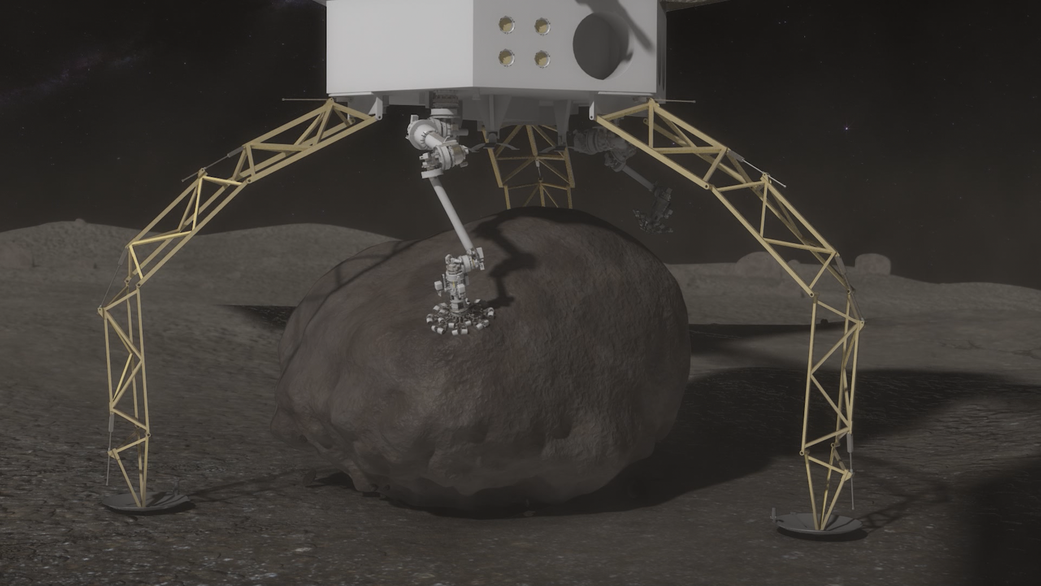
Caption and Credits: NASA
NASA’s Asteroid Redirect Mission (ARM) plans to send a robotic spacecraft to a near-Earth asteroid to pluck a boulder off the surface and move it into a stable orbit around the Moon. After announcing back in March that the agency will move forward with the plan known as “Option B,” the agency is now calling for American Industry ideas on spacecraft development and design. The robotic part of the mission, known as the Asteroid Redirect Robotic Mission (ARRM), requires a core advanced solar electric propulsion-based spacecraft to support it, and NASA’s Jet Propulsion Laboratory (JPL) in Pasadena, Calif., is opening up the opportunity to American companies to design the ARRM spacecraft.
The ARM robotic spacecraft is planned to launch in 2020, travel to a large asteroid, and capture a boulder off its surface. Once the boulder is in its possession, the spacecraft will redirect and place it in a stable orbit around the moon known as a “Distant Retrograde Orbit.” Astronauts launched off the Space Launch System (SLS) deep space rocket will travel aboard the Orion spacecraft and explore the orbiting rock.
The mission will also use a variety of important technologies that will help prepare NASA for a future human exploration mission to cis-lunar, the area around the Moon, and deep space. The robotic part of the ARM mission will also provide the first asteroid samples on a large scale, as opposed to the meteorites that are studied in laboratories. These samples will be researched and analyzed to give a more thorough understanding of asteroid nature and composition. This is very important for those interested in the benefits of asteroid mining. Companies like Planetary Resources seek to take advantage of the abundance of potential resources on asteroids because it can boost the economy and make spaceflight more efficient. Parking a large asteroid in a distant retrograde orbit will give the first human and robotic explorers and American commercial enterprises the first opportunity to determine the likelihood of mining asteroids for precious metals and resources. Some of the precious metals and resources include ruthenium, rhodium, palladium, osmium, iridium, platinum, iron, nickel, cobalt, and more.
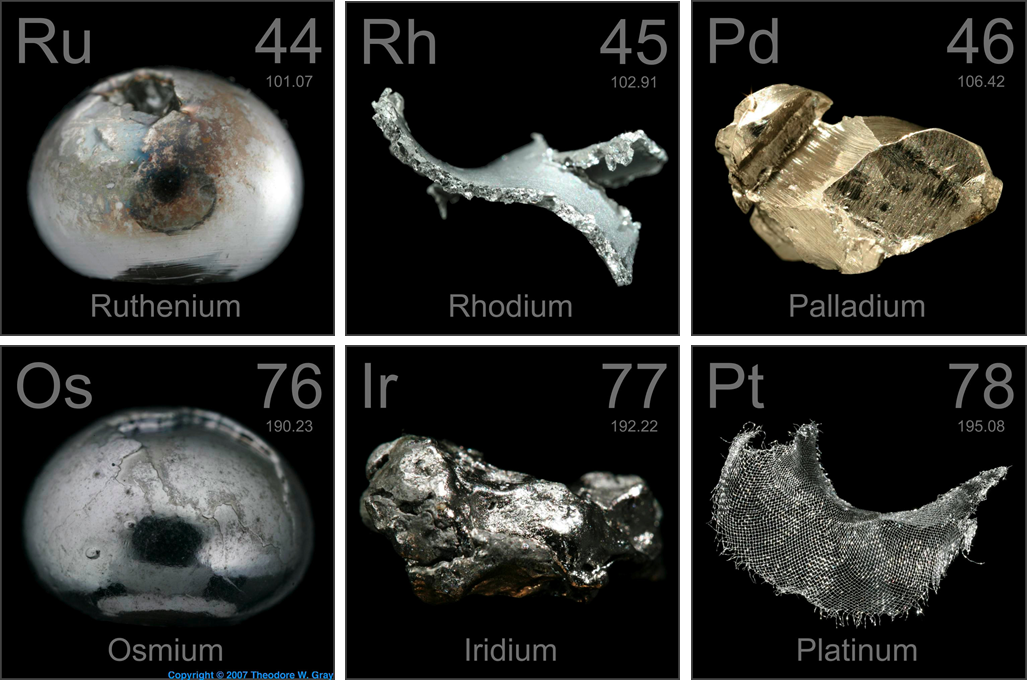
NASA is developing the technology to deflect asteroids, too, as many of them fly by Earth almost daily and some go undetected. ARM elaborates on the agency’s ability to find, characterize, and alleviate the life-threatening danger asteroids pose to Earth. While the spacecraft is at the large asteroid, it will demonstrate a “slow-push” planetary defense maneuver. This deflection technique uses the ARRM spacecraft and the boulder’s gravitational pull to put the asteroid on a different course. The top priority for ARM, however, is to efficiently demonstrate and verify new capabilities necessary for future manned missions to Mars and deep space.
“We’re eager to hear from American companies on their ideas for a spacecraft design that could accommodate our advanced solar electric propulsion requirements and robotic technologies,” said NASA Associate Administrator Robert Lightfoot. “We’re also interested in what sorts of innovative commercial, international and academic partnerships opportunities might be practical and help reduce overall mission costs while still demonstrating the technologies we need for our journey to Mars.”
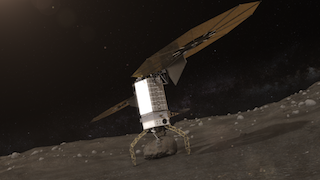
Caption and Credit: NASA
NASA’s ARRM spacecraft will have to be able to perform a number of technology demonstrations that are necessary for a human exploration mission to Mars. This includes a “20-fold improvement in state-of-the-art deep space solar electric propulsion capability to move and maneuver multi-ton objects.” The robotic portion of ARM has the objective to collect a multi-ton mass from a significantly sized asteroid and redirect it to an orbit around the Moon that could be accessed by a crew. This sets the stage for future crewed and robotic vehicle missions in deep space.
The ARRM spacecraft must be able to demonstrate high power solar electric propulsion (SEP). This advanced SEP technology is critical for sending larger payloads, habitats, and propellant into deep space and to Mars ahead of a human mission. Traditional chemical propulsion creates thrust by using combustion and a nozzle; on the contrary, SEP utilizes electricity from solar arrays to make electromagnetic fields to speed up and eject charged atoms, or ions, to build a small thrust with an efficient use of rocket propellant. The ARM mission uses nearly five to 10 times less rocket propellant, when compared with chemical propellant sources, because of the advanced SEP technology. The solar arrays must have the initial power of approximately 50 kW. The capture system aboard the ARRM spacecraft must be capable of collecting a 20 ton (or larger) boulder of no more than 19 feet (six meters) wide from the surface of an asteroid and place it in a fixed orbit around the Moon where astronauts can easily travel to it. The ARRM spacecraft is being designed to work with a number of launch vehicles, such as NASA’s Space Launch System (SLS) rocket, or a launch vehicle provided by a commercial company. It will test the largest and most powerful SEP system ever used for space missions. It will also test how NASA’s Orion spacecraft can dock with and operate with a SEP-powered spacecraft. The robotic asteroid-capturing spacecraft must be ready to launch by the end of the decade.
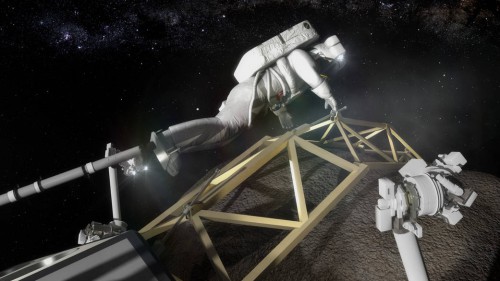
ARM is an important step in preparing NASA for the journey to Mars. The mission to pluck a heavy boulder off the surface of an asteroid and park it in the Moon’s orbit brings together the best of NASA’s abilities. NASA’s science, technology, and human exploration efforts will come together to achieve many important goals that are critical to the journey to the Red Planet.
Some of the technologies to be tested on ARM before the mission to Mars are: solar electric propulsion, trajectory and navigation, advances in spacesuits, sample collection and containment techniques, rendezvous and docking capabilities, and developing the building blocks for exploration.
Be sure to “Like” AmericaSpace on Facebook and follow us on Twitter: @AmericaSpace
.
Missions » SLS » Missions » SLS » Asteroid Redirect (ARM) »



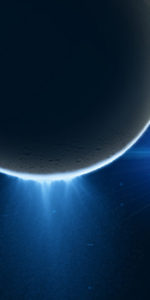
Once the satellite is in stable orbit and sufficient samples analyzed to characterize the gross content, I suggest that NASA auction it off as an economic experiment. I doubt it will cover mission cost, but who knows?
It is all about not going back to the Moon. History will not be kind.
“The robotic part of the ARM mission will also provide the first asteroid samples on a large scale, as opposed to the meteorites that are studied in laboratories.”
“The capture system aboard the ARRM spacecraft must be capable of collecting a 20 ton (or larger) boulder of no more than 19 feet (six meters) wide from the surface of an asteroid and place it in a fixed orbit around the Moon where astronauts can easily travel to it.”
“The ARRM spacecraft is being designed to work with a number of launch vehicles, such as NASA’s Space Launch System (SLS) rocket, or a launch vehicle provided by a commercial company.”
Colorado – “It is all about not going back to the Moon. History will not be kind.”
Yep.
Russia and several other nations are planning to go to the Moon’s surface to tap millions of ‘minable asteroids’ plus frozen water, CO2, NH3, and other useful frozen volatiles in the Moon’s polar regions while our President is advocating a highly partisan and scientifically useless launch mission for a “launch vehicle provided by a commercial company” which, given the highly politicized situation of NASA’s leadership not fully implementing our relevant space law law, probably means “a commercial” launcher from the company of the President’s favorite ‘pseudo Martian huckster’.
NASA’s leadership has become the de facto publicity agency of that ‘political huckster friend of the President’ and is completely unwilling to make the needed plans for fully implementing the broadly bipartisan pro Moon exploration NASA Authorization Act of 2010 (PL 111–267) of September 29, 2010, an act that the President signed into law but has repeatedly tried to ‘slow roll’ or ‘sabotage’ its full implementation.
Read that law and compare it to the nonsense continually blathered by NASA’s highly politically partisan leadership which is now getting to the point of becoming completely irrelevant in providing leadership for beyond LEO international human space missions.
“the ARM mission will also provide the first asteroid samples on a large scale” is scientific mumbo jumbo nonsense because all the samples will be from only one “20 ton (or larger) boulder of no more than 19 feet (six meters) wide”.
If NASA actually wanted a diversity of asteroid samples it would send folks to meteorite museums or lead the legally required international missions to the Moon. According to ‘Meteorite’ at Wikipedia, we currently have “more than 38,660 well-documented meteorite finds”.
And if a “large” size is a scientific prerequisite, NASA should study the intact 60 tonne Hoba meteorite that has been excavated and continues to ‘sit’ at the site where it impacted at 720 miles per hour in Namibia.
The Hoba meteorite and “38,660 well-documented meteorite finds” would be much safer, far cheaper, easier, and more useful objects for extensive NASA research.
If studying a space “boulder” actually was a real scientific goal for “NASA’s Asteroid Redirect Mission”, there are many other large meteorites in museums.
We American can either have a national beyond LEO human space program that fully meets the requirements of our relevant space law and the Lunar expectations and goals of our international space exploration partners, or we can have a narrow and highly partisan ‘national’ beyond LEO human space program that is carefully designed to primarily divert ever increasing amounts of NASA’s budget to the President’s ‘political huckster friend’.
Which is it going to be?
James, For the less well informed, please name the huxter.
From the standpoint of creating an in-space economy, I believe returning to the moon (or going to Mars) is not well advised. Having, at great expense and effort escaped one gravity well, why colonize another? If congress desires to return to the moon, I bid it good riddance. Until you invent antigravity, the only model that has a prayer of economic payoff is asteroid mining. I believe this mission is in line with the original NACA (remember them?) mission of developing technology that supports potentially viable commerce.
The Hoba meteorite cited is just another nickel-iron meteorite of little scientific interest. Characterizing other classes of meteorites that have not been heavily modified by passage through our atmosphere could help in scouting potentially valuable asteroids. BTW, I find it remarkable that the estimated terminal velocity was merely 720 mph.
I await your reply with interest.
Glenn,
I believe you may be arguing with people that do not understand that a positive ROI is required for any activity to expand and grow. With negative ROI, the activity only lasts as long as the subsidies do. While I may disagree with you on moon vs asteroids,* I think we agree that creating a positive space economy is a prerequisite for settling space.
*I support many destinations by many players.
“*I support many destinations by many players.”
Me too. And the key gateway resource and experience ‘base camp’ for that extensive human diaspora across the Solar System is the nearby Moon.
ROI on broad national security and international diplomatic cooperation efforts are both quite real and a bit tricky to quantify. If NASA providing leadership in tapping extensive Lunar resources with various national and international partners could be quite useful in those two broad areas, then let’s fully implement the bipartisan and pro Moon exploration NASA Authorization Act of 2010 (PL 111–267).
“If congress desires to return to the moon, I bid it good riddance. Until you invent antigravity, the only model that has a prayer of economic payoff is asteroid mining.”
Asteroid mining….really? That is the biggest scam of all. Mining on Earth is far, far, more economical than launching billion dollar missions into deep space. It is just another con like retirement condos on Mars and strip clubs in LEO. That huxter need not be named since his hobby rocket blew up and his bizarro plans are all falling apart one by one.
The reason the Moon is the only place to go is simple and it has to do with human physiology, which is not going to change any more than the laws of physics. Go beyond LEO and the protection of the Van Allen belts and the radiation environment becomes intolerable for any long duration human habitation- unless the habitat is shielded. Massively shielded. The “economic payoff” for establishing a permanent human presence Beyond Earth Orbit is simple survival and a survival colony is in fact a national defense issue. Considering we just contracted a 100 billion dollar Northrop Grumman Long Range Strike Bomber program I think your “economic payoff” argument is……baloney.
Since lifting those thousands of tons of tapwater-as-shielding out of Earth’s gravity well is not going to happen and the nuclear energy to push that shield around is not going to happen inside Earth’s magnetosphere (or nuclear devices handed over to billionaire hobbyists) that leaves one place to both acquire the shielding and assemble, test, and launch nuclear missions- the Moon.
And so I bid YOU good riddance.
“From the standpoint of creating an in-space economy-”
I just have to add that the entire space-is-only-about-money crowd is constantly trying to portray themselves as the voice of authority when they are truly the very worst thing that has ever happened to space exploration. There is no cheap and all these space clown wanababe’s and meteor miners and their tony stark/howard roark/john galt hero-worship is setting space exploration back decades. The damage continues to accumulate. It will be GOOD RIDDANCE when the NewSpace movement finally goes down in flames as it inevitably must.
“Mining on Earth is far, far, more economical than launching billion dollar missions into deep space.”
That says it all right there.
“Mining on Earth is far, far, more economical than launching billion dollar missions into deep space.”
See: “Lunar Water Creates New Capabilities in Space” October 8, 2015 by Paul Spudis
As for me, I believe humans should be permanently everywhere in our Solar System ASAP.
We humans could have stayed in Africa long ago, but we didn’t.
Instead, we went to difficult places to live and build homes. And by doing that we discovered new means of sustaining our families.
Strangely enough, we didn’t need some ‘huckster billionaire’ to tell us how to do that.
I strongly doubt we need any ‘nonscientific huckster billionaire’ lecturing us about how his private business will explore our Solar System while he is at the same time reaching deep into the pockets of American taxpayers and helping his ‘friend’ the President to ‘politically slow roll and sabotage’ the pro Moon exploration NASA Authorization Act of 2010 (PL 111–267) of September 29, 2010 and the legally required, and repeatedly budgeted by Congress, SLS and Orion.
And it should be an obvious thought experiment that the future human and robotic Martians also won’t want to put up with the ‘huckster’s self-serving opinions, manipulating bluster, and crude cult political games’.
Unfortunately for us, if he actually does the unlikely and goes to Mars, those future Martians will ship that ‘huckster’ back to Earth ASAP.
“Mining” generally means precious metals in this context. The ice on the Moon is not asteroid mining for precious metals.
The reason the ice on the Moon is the critical enabling resource for human expansion into the solar system is space radiation. Cosmic radiation is the dirty little secret NASA will not talk about. Any future spaceship will, ironically, be somewhat like a ship at sea on Earth in that the crew will be wrapped in hundreds and almost certainly thousands of tons of water-as-radiation shielding. Since chemical energy is essentially useless for pushing such a massive shield around the solar system it follows that nuclear energy is also required. It also follows, to add to the eye-roll factor, that only one form of nuclear propulsion is practical; nuclear pulse propulsion (H-bombs). Since lighting off these devices anywhere in the Earth’s magnetosphere will eventually find the fallout in the Earth’s atmosphere that takes us once again to the Moon.
This simple explanation of the inconvenient and politically incorrect reality of Human Space Flight is completely rejected by the mainstream. Yet it is completely factual and true.
Colorado – Generally I agree with most of your posts.
Many of my posts that were erased from the Internet dealt with some of the ramifications of needing to extensively shield astronauts against extremely nasty Galactic Cosmic Radiation.
I like the concept of the nuclear explosion powered original large Orion spaceship.
Nonetheless, I disagree “that only one form of nuclear propulsion is practical; nuclear pulse propulsion (H-bombs)”.
There are other future options in moving extensively shielded crews around our Solar System.
Antimatter based rocket engines of various kinds are coming and producing that antimatter on the Moon might eventually make a lot of sense.
See:
‘ICAN-II’ at Wikipedia
‘CERN Prepares to Test Revolutionary Mini Accelerator Machines that “surf” particles on electric fields could reach high energies at a lower price’ By Elizabeth Gibney and Nature magazine October 7, 2015
‘China Building MASSIVE Particle Accelerator Twice The Size Of Large Hadron Collider’ Fri, 30 Oct, 2015
Perhaps more is getting considered than what is easy to find on the Internet.
Dual use implications are a bit difficult to avoid.
Generally I disagree with your support of the ISS and as for anti-matter. Nah.
Bombs work and they are for the foreseeable future the only thing that will. The other option is fission fragment propulsion- if you were as well read as you seem to be claiming you would know that Americium 242 is the stuff to go places with. Except it would require building a completely new nuclear industry from the ground up to the tune of a trillion dollars or so for starters. But mass producing Am-242 is child play compared to antimatter. You need to study up.
And I would add your speculation that Musk would be sent back to Earth from Mars does nothing to help space exploration- it is just indulging in juvenile mischief. It is ridiculous and you should stop.
What is “ridiculous” or “indulging in juvenile mischief” or ‘running a con’ is that years ago the ‘huckster’ repeatedly and publicly claimed he was going to retire on Mars in fifteen years and also transport thousands of people to Mars. Actually, that sounds like a cult to me.
What is “ridiculous” or “indulging in juvenile mischief” or ‘running a con’ is that the ‘huckster’ routinely makes nonscientific Mars fantasy claims and gets away with them because no one seems to be willing or able to confront him.
What is “ridiculous” or “indulging in juvenile mischief” or ‘running a con’ is that the President seems to have ‘anointed’ the ‘huckster’ to be the one who puts the ax to the SLS and Orion enabled Lunar missions that are clearly required in the broadly bipartisan pro Moon exploration NASA Authorization Act of 2010 (PL 111–267) of September 29, 2010.
What is “ridiculous” or “indulging in juvenile mischief” or ‘running a con’ is a NASA administrator claiming his agency would be “doomed” if it deviates from some vague plan to go to Mars that is not currently supported in Congress and is also not supported in the relevant and broadly bipartisan pro Moon exploration NASA Authorization Act of 2010 (PL 111–267) of September 29, 2010.
What is “ridiculous” is defending a ‘huckster’ who has ‘grabbed onto’ a twenty year monopoly of a critically needed SLS national launchpad asset in order to further his own narrow monetary interests and ‘conveniently sabotage’ some of the Lunar mission capability of the SLS and Orion.
What is “ridiculous” is criticizing someone who bluntly notes the “huckster’s self-serving opinions, manipulating bluster, and crude cult political games” right after you have just demonstrated a similar sarcastic and blunt tendency concerning the ‘huckster’s’ many confused or naive followers.
Colorado
October 29, 2015
“There is no cheap and all these space clown wanababe’s and meteor miners and their tony stark/howard roark/john galt hero-worship is setting space exploration back decades. The damage continues to accumulate. It will be GOOD RIDDANCE when the NewSpace movement finally goes down in flames as it inevitably must.”
You will note the “tony/howard roark/john galt hero-worship” remark is NOT a personal insult to Elon Musk. That is YOUR problem and you need to tone it down. You can insult SpaceX and NewSpace and their cult followers in a general way but your borderline conspiracy ranting turns people off. This is a public forum and people come here to first read the stories and then some read the comments. The few who do will impart their own thoughts on the subject matter to others- and what they impart about your over-the-top tissy fits will not help space exploration at all.
In other words, no matter how close to the truth your harangue is, it is actually a good thing for those you claim to be railing against. And since I am a confirmed critic of the NewSpace mob, and even though I agree with much of what you are writing, I will continue to do the “ridiculous” and tell you to stop acting like some Rush-Limbaugh-in-space bloviator.